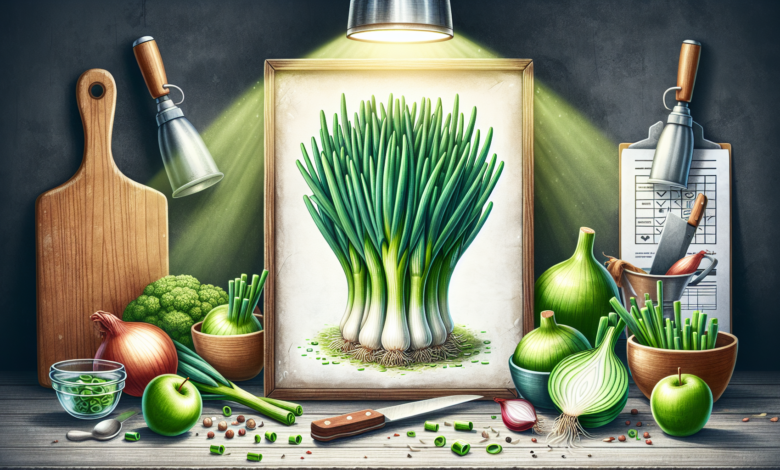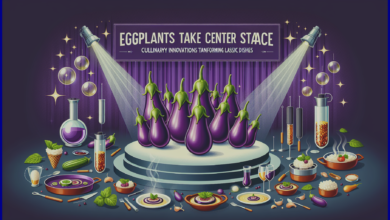Scallions Unveiled: The Versatile Green Onion’s Culinary Secrets and Health Benefits

Introduction
Picture this: a vibrant, crisp green stalk, slicing through your favorite dishes with ease, infusing them with a pop of flavor and color. Enter the scallion, or green onion, a staple that elevates everything from salads to stir-fries. This beloved vegetable is not just a garnish; it’s a culinary powerhouse that has found its way into the kitchens of America and beyond. Available year-round, scallions are celebrated for their refreshing taste and versatility, making them a go-to in countless cuisines. But beyond their flavor, they play a pivotal role in promoting a healthy lifestyle. Let’s dive into the world of scallions and discover their hidden secrets!
Description
Originating from Asia, scallions have a rich history that spans civilizations. These slender stalks, often mistaken for their bulbous counterparts, the shallots, boast a delicate flavor profile that ranges from mild to pungent, depending on the variety. The green tops offer a bright, grassy taste, while the white portion provides a sharper bite. There are two primary types – the "bunching" scallion, which doesn’t form a bulb, and the "bulb" scallion, which has a small bulb at the base. These green gems flourish in temperate climates, thriving in the warm soils of the USA, especially from spring through early fall.
Interesting trivia? The use of scallions dates back thousands of years, with mentions in ancient Chinese texts, where their medicinal properties were revered. They were considered a symbol of vitality and longevity, a nod to their dual role in both cooking and health.
Health Benefits
Packed with essential vitamins and minerals, scallions are nutrient-dense little wonders. They are particularly rich in vitamin K, which is crucial for bone health, and vitamin C, a potent antioxidant that supports the immune system. But that’s just the tip of the iceberg! A research study from the American Journal of Clinical Nutrition found that regular consumption of scallions can enhance heart health due to their flavonoid content, which helps reduce blood pressure and cholesterol levels. Moreover, their high fiber content aids digestion and facilitates weight management.
Experts suggest that the sulfur compounds found in scallions may even possess cancer-fighting properties, giving a whole new meaning to the phrase “eating your greens.” Such impressive nutrients make scallions a logical choice for anyone looking to boost their diet!
How to Use
Embracing scallions in your culinary repertoire is a breeze. Toss them raw into salads for a crisp texture, or use them as a base for savory dishes like stir-fries and soups. They can be grilled, roasted, or steamed, offering versatility that few vegetables can match. Try pairing scallions with eggs for a delightful breakfast scramble or incorporating them into creamy dips and sauces. Their mild yet distinctive flavor complements a range of foods, from seafood to earthy grains, creating a delightful harmony on your palate.
Quick Tips for Use:
- Slice them thinly and sprinkle over tacos for a fresh kick!
- Blend into pesto for an unexpected twist.
- Add to sushi rolls for an extra layer of flavor.
Recipes
Simple Scallion Salad
Ingredients:
- 1 bunch of scallions, chopped
- 1 cucumber, diced
- 1 cup cherry tomatoes, halved
- 2 tablespoons olive oil
- 1 tablespoon balsamic vinegar
- Salt and pepper to taste
Instructions:
- In a large bowl, combine scallions, cucumber, and tomatoes.
- Drizzle with olive oil and balsamic vinegar. Toss gently.
- Season with salt and pepper to taste.
- Serve immediately for a refreshing dish!
More Complex Ideas:
Check out recipes for scallion pancakes, scallion-infused soups, or a spicy scallion salsa!
Quick and Easy Recipes:
- Sauté scallions with garlic in oil for an aromatic side dish.
- Mix scallions into homemade potato salad for a flavorful crunch!
Tips for Buying & Storing
When shopping for scallions, look for fresh, vibrant green tops without any wilting or browning. The white bulb should be firm, not mushy. It’s best to consume them in their peak season from spring through early fall, but they are widely available throughout the year.
For storage, place scallions in the refrigerator wrapped in a damp paper towel and sealed in a plastic bag. This can help maintain their crispiness. Alternatively, you can root them in a glass of water on your windowsill for a fun and decorative way to keep them fresh!
Precautions & Considerations
While scallions are generally safe for most, some people may experience minor allergies or sensitivities. Moreover, individuals on a low-sodium diet should enjoy them in moderation, as certain scallion preparations can be saltier than intended. Always consult with a healthcare professional if you’re unsure about incorporating new foods into your diet.
Conclusion
In summary, scallions are more than just a kitchen staple; they are a beacon of health, flavor, and versatility. With their myriad benefits and culinary applications, it’s high time to embrace this underrated vegetable. So, why wait? Add this vibrant green onion to your next grocery list and start reaping the health benefits today! Your taste buds, and your body, will thank you!




